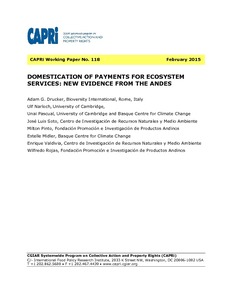The objectives of this paper are to help build a picture of the role of women in China’s agriculture, to assess whether or not agricultural feminization has been occurring, and if so, to measure its impact on productivity. To meet these goals, we rely on three datasets that allow us to explore who is working on China’s farms and the effects of the labor allocation decisions of rural households on productivity. We find that since 2000, the role of women has increased both in the supply of farm labor and in the duties that women take on in the management of farms.
Search results
Showing items 1 through 9 of 46.-
Library ResourceReports & ResearchJune, 2012Asia, China
-
Library ResourceReports & ResearchJanuary, 1997Indonesia
It is widely believed that land tenure insecurity under a customary tenure system leads to socially inefficient resource allocation. This article demonstrates that land tenure insecurity promotes tree planting, which is inefficient from the private point of view but could be relatively efficient from the viewpoint of the global environment. Regression analysis, based on primary data collected in Sumatra, indicates that tenure insecurity in fact leads to early tree planting.
-
Library ResourceReports & ResearchDecember, 1998
-
Library ResourceReports & ResearchDecember, 2013Africa, Asia, Central America, South America
The food security crisis, international "land grabs,? and new markets for environmental services have drawn renewed attention to the role of natural resource competition in the livelihoods of the rural poor. While significant empirical research has focused on diagnosing the links between natural resource competition and (violent) conflict, much less has focused on the dynamics of whether and how resource competition can be transformed to strengthen social-ecological resilience and mitigate conflict.
-
Library ResourceReports & ResearchApril, 2011Kenya, Africa, Eastern Africa
-
Library ResourceConference Papers & ReportsDecember, 2002Ethiopia, Africa, Eastern Africa
This paper evaluates the nature and determinants of community management (collective action) of woodlots and grazing lands in the northern Ethiopian highlands of Tigray. It identifies the nature of management of woodlots and grazing lands, the roles of different organisations (local and external) in managing them, and the benefits and problems encountered. Econometric analysis was used to investigate the determinants of collective action and its effectiveness in managing these resources. The paper ends with comment from Ephraim Nkonya.
-
Library ResourceReports & ResearchJanuary, 2010Kenya, Africa, Eastern Africa
-
Library ResourceConference Papers & ReportsDecember, 2002Ethiopia, Africa, Eastern Africa
Using a household bioeconomic modelling approach, this paper analyses the impact of advancing in-kind credit in the form of fertilizer and seed on smallholder farmers with different levels of wealth in the Ethiopian highlands. Cropland allocation and household consumption patterns are examined in relation to credit availability. The paper then explores appropriate policy mechanisms for advancing credit to smallholder farmers in order to encourage intensification.
-
Library ResourceReports & ResearchSeptember, 2013Ethiopia, Kenya, Uganda, Africa, Eastern Africa
This paper describes an action research process undertaken with four African agricultural carbon projects—CARE’s Sustainable Agriculture in Changing Climate Initiative in Western Kenya; World Vision’s Assisted Natural Regeneration Project in Humbo, Ethiopia; Vi Agroforestry’s Western Kenya Agricultural Carbon Project; and ECOTRUST’s Trees for Global Benefits in Uganda—to explore their institutional changes as project managers and communities work to build local capacity for project management.
-
Library ResourceReports & ResearchDecember, 2015
The current project has sought to assess i) the potential of agricultural biodiversity-focused PES to serve as a cost-effective and socially equitable domesticated diversity conservation incentive scheme, as well as ii) how economic incentive mechanisms such as PES can be designed to build on and complement local institutions of collective action. Results are presented from pilot Payment for Agrobiodiversity Conservation (PACS) schemes and framed field experiments implemented in the Bolivian and Peruvian Andes aimed at sustaining diversity within quinoa, a traditional Andean grain.
Land Library Search
Through our robust search engine, you can search for any item of the over 64,800 highly curated resources in the Land Library.
If you would like to find an overview of what is possible, feel free to peruse the Search Guide.








